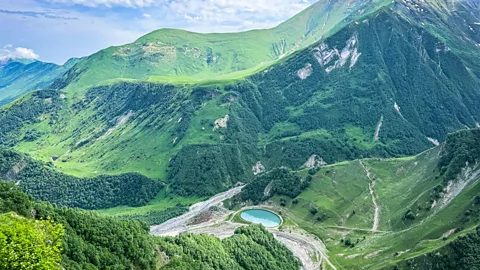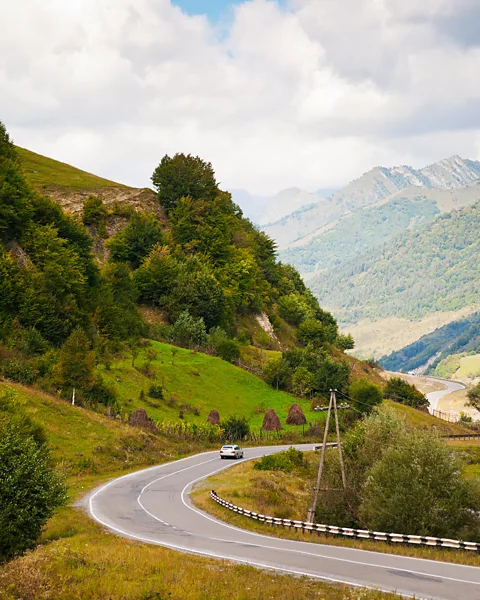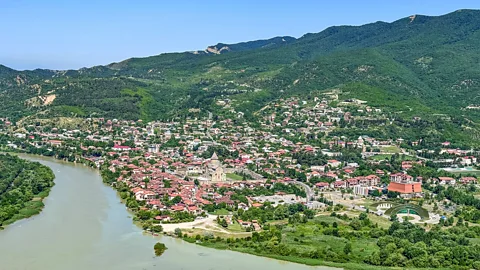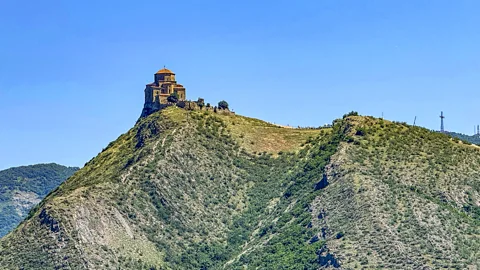A 210km drive through 'the most beautiful place on Earth'
 Soumya Gayatri
Soumya GayatriFollowing a traditional path used by traders and invaders, the Georgian Military Road has been a ageway for people and ideas since antiquity.
As my car snakes its way through the Georgian Military Road, a 210km route that twists and turns through Georgia's Caucasus Mountains, I am greeted by lush valleys crisscrossed by gurgling rivers, mountains overgrown with wildflowers and picturesque villages perched on the edge of cliffs. Occasional Georgian Orthodox churches, complete with beautiful barrel domes, appear on the horizon and rows of coloured Soviet mosaics adorn deserted bus stop walls. At one stop, a smiling vendor breaks into song as he hands me a plate of Georgian dumplings by the shimmering blue Aragvi River.
"It is funny, not many tourists visit this part of Georgia. But it is the most beautiful place on Earth and my favourite," says Mirian Takvarelia, a driver at GoTrip Georgia, a local ride-hailing company that hires taxis for multiday trips within the country. "You need to come here only once to fall in love with the Caucasus."
When I ask Takvarelia how long he has been driving tourists on the Georgian Military Road, he smiles. "Too long, " he replies "Maybe 15-16 years now."
Sixteen years may not signify much in other countries, but in the South Caucasian country of Georgia, it marks the end of the five-day Russo-Georgian War of 2008 that left a trail of devastation on the Georgian Military Road. Georgia was part of the Soviet Union from 1921-1991 and the road, which connects Tbilisi with the Russian town of Vladikavkaz, is the only direct overland route connecting Georgia with the Russian Federation.
However, the nation has a much longer history of conflict. Historically, Georgia was an object of rivalry between the Romans, Persians, Ottomans and Russians owing to its strategic location between Europe and Asia. Georgia was also home to an ancient road in the Caucasus Mountains that connected the two continents. The road was called Porta Caucasia and played a crucial role in ferrying troops between empires and launching attacks.
 Alamy
AlamyIn the 18th Century, following the Treaty of Georgievsk, the Russians established Porta Caucasia as a modern military thoroughfare, which led it to be known as the Georgian Military Road. This route went on to play a key role in many Russian military offensives in the 18th and 19th Centuries, including the Caucasian War, the Russo-Circassian War and the Murid War.
Military history aside, Porta Caucasia was also an important part of the Great Silk Road connecting China with the Mediterranean. Caravans full of silk, spices and jewellery ed along here, while ancient writers like Strabo and Pliny the Elder waxed about the road's natural beauty. Even today, it is an extremely busy route, ferrying everything from cheap electronics to fragrant Armenian flowers within the Caucasus region.
As a ageway for people and ideas since antiquity, the surrounding region's rich cultural heritage have often been overshadowed by conflict. "[Georgian Military Road] is full of art and architecture and represents the beautiful historical heritage of our country," says Sofia Knoeva, a local tour guide at Friendly.ge. "Every tour company in Georgia is now incorporating the Military Road into their basic packages for foreign tourists so that people can experience the region's cultural richness."
Over the next three days, Takvarelia and I chart out an itinerary along the road, from Tbilisi in the south to Stepantsminda in the north, stopping at remote monasteries, Soviet-era mosaics, restaurants serving plates of khinkali (Georgia's giant dumplings) and lush valleys dotted with ruined medieval fortresses.
 Soumya Gayatri
Soumya GayatriWe begin in the historic city of Mtskheta, the seat of the Georgian Orthodox Church since the 4th Century. Located on the confluence of the Kura and Aragvi rivers, Mtskheta was a key Silk Road trading hub and a holy capital city. It was here that Saint Nino arrived in AD337 and eventually converted Georgia to Christianity.
Mtskheta is now a Unesco World Heritage Site and home to three churches – the Jvari Monastery, the Samtavro Monastery and the massive complex of the Svetitstkhoveli Cathedral. The Samtavro Monastery complex is home to the graves of King Mirian, the first Christian king of Georgia, and his queen Nana; while the Svetitstkhoveli Cathedral, is believed to house Jesus Christ's robe that was brought to Mtskheta by a Georgian Jew named Elioz.
At the 11th-Century cathedral complex, I ire beautifully carved stone reliefs, vivid religious iconography and intricate frescoes. A set of old quevri wine pots in the garden harkens back to when the cathedral made and stored its own wine in these underground earthen vessels. As I stroll through Mtskheta's historic centre, where vendors sell everything from enamelled jewellery and traditional rugs to fragrant spices and wine ice cream, I am transported back to a time when Silk Road caravans would have halted in this ancient city for food, rest and trade.
The most iconic monument in the Mtskheta Unesco ensemble, however, is the tiny Jvari Monastery from the 6th Century. Perched on a cliff overlooking the rivers, this is one of the few surviving examples of early medieval Georgian church architecture, complete with intricate bas-reliefs and Asomtavruli (ancient Georgian script) inscriptions. The church was built at the site of the first wooden cross erected here in the 4th Century to signify the rise of Christianity in Georgia and is still one of the most sacred pilgrimage sites in the Caucasus.
 Soumya Gayatri
Soumya GayatriAfter a day of exploring Mtskheta's religious past, I head deeper into the mountains to explore Georgia's vanishing Soviet mosaics. At the quaint village of Tsikhisdziri, I ask to pull over at a deserted bus stop to ire a colourful – if crumbling – ceramic depicting lions, horses, mythical birds and folk images depicted in bright red, blue and yellow.
"Why do you want to stop here">window._taboola = window._taboola || []; _taboola.push({ mode: 'alternating-thumbnails-a', container: 'taboola-below-article', placement: 'Below Article', target_type: 'mix' });
